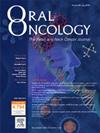Augmented reality in preoperative anterolateral thigh flap perforators positioning: A pilot diagnostic study
IF 4
2区 医学
Q1 DENTISTRY, ORAL SURGERY & MEDICINE
引用次数: 0
Abstract
Background
The anterolateral thigh (ALT) flap is the primary choice for healthy and vascularized soft-tissue coverage for appendicular and axial soft tissue reconstruction, especially in the head and neck regions. Nonetheless, there is substantial anatomic variation in ALT perforators that affect flap integrity, survival rates, and donor-site morbidity. Regardless of the ALT flap type, accurate location of perforators can greatly improve surgical success rates and reduce the risk of secondary surgeries. Therefore, we investigated a novel approach for locating perforators.
Method
We utilized augmented reality (AR) technology in combination with a self-designed device, Finder, to locate the perforators of the anterolateral thigh (ALT) flap, and compared its accuracy to that of traditional ultrasound localization.
Result
In this study, 24 patients underwent ALT flap reconstruction, with all flaps surviving except one case of partial necrosis. Comparing the two positioning methods, Ultrasonic color Doppler (UCD) showed a sensitivity of 81.1 % [95 % confidence interval (CI) 64.3 %–91.4 %] and an AUC of 0.70 (95 % CI 0.55–0.86). AR-Finder demonstrated a higher sensitivity of 97.5 % (95 % CI 85.3 %-99.9 %, p = 0.031) and an AUC of 0.90 (95 % CI 0.80–1.01, p = 0.035). The average distance difference from the actual perforator to virtually determined location was 3.54 ± 2.80 mm (95 % CI 2.58–4.50) for AR-Finder and 9.57 ± 5.84 mm (95 % CI 7.75–11.58) for UCD (p < 0.001).
Conclusion
In this pilot study, AR-Finder demonstrated superior accuracy compared to the UCD method for locating perforators in ALT flaps, providing a new and reliable tool for the design and elevation of ALT flaps.
求助全文
约1分钟内获得全文
求助全文
来源期刊

Oral oncology
医学-牙科与口腔外科
CiteScore
8.70
自引率
10.40%
发文量
505
审稿时长
20 days
期刊介绍:
Oral Oncology is an international interdisciplinary journal which publishes high quality original research, clinical trials and review articles, editorials, and commentaries relating to the etiopathogenesis, epidemiology, prevention, clinical features, diagnosis, treatment and management of patients with neoplasms in the head and neck.
Oral Oncology is of interest to head and neck surgeons, radiation and medical oncologists, maxillo-facial surgeons, oto-rhino-laryngologists, plastic surgeons, pathologists, scientists, oral medical specialists, special care dentists, dental care professionals, general dental practitioners, public health physicians, palliative care physicians, nurses, radiologists, radiographers, dieticians, occupational therapists, speech and language therapists, nutritionists, clinical and health psychologists and counselors, professionals in end of life care, as well as others interested in these fields.
 求助内容:
求助内容: 应助结果提醒方式:
应助结果提醒方式:


